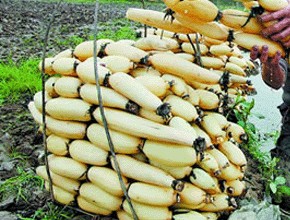Matters needing attention in planting Fritillaria
Fritillaria was very similar to barley in appearance. Many people thought they were the same plant. In fact, it was not like this. Fritillaria was a very expensive traditional Chinese medicine. The annual yield was not very high, but its cough and heat dissipation effects were very strong. In fact, there were many Fritillaria planted now. Why was the annual yield not high? At this time, because we did not consider some aspects of planting, so pro-agricultural network to share with you some matters to pay attention to the cultivation of Fritillaria, I hope to help you.

1. Time
The survival rate of Fritillaria planting is related to the planting time of Fritillaria, because each crop has the most suitable period for its own growth. For example, rice, which is the most common in our daily life, can only be planted at the right time to produce high yield. Therefore, we must pay attention to the planting time when planting Fritillaria. Generally, we can start planting in June, but if we want high yield, it is best to sow in September. This period of time is the best growth period of Fritillaria.
2. Temperature
The growth of Fritillaria is also affected by temperature. At different temperatures, the growth of Fritillaria is different. Although Fritillaria has the effect of heat dissipation, it cannot survive in a relatively high temperature environment. Under normal circumstances, the temperature suitable for Fritillaria germination should be around 25 degrees, usually the growth process temperature is best maintained between 20 to 25 degrees, the highest temperature can not be higher than 30 degrees, so we have to carry out heat treatment in summer, but Fritillaria growth temperature can not be lower than five degrees, so Fritillaria will stop growing, so in winter we still have to carry out insulation treatment, so as to ensure the normal growth of Fritillaria.
3. Soil
The survival rate of Fritillaria and the yield of Fritillaria are related to the selection of planting land. If you choose a plot with relatively wet soil or relatively high soil viscosity or too dry soil and relatively poor soil acidity or alkalinity, then the survival rate and yield of Fritillaria will be greatly reduced. Therefore, we should test the pH value of the soil before planting to see if it is reasonable. The second is to try to plant in plots with sufficient soil fertility and loose soil, so that the soil permeability is better, which can improve the survival rate of plants and enhance immunity.
4. Water
Fritillaria growth environment moisture should not be too high, that is, although it is not drought tolerant, but also not waterlogging, under normal circumstances is to ensure that the humidity in the field at about 50%, that is, in the case of no rainfall, watering every week or so, followed by more rainfall in the rainy season, we still need to control the moisture in the field at about 50%, so we must timely discharge excess water, can not cause Fritillaria disease, affect growth.
5. Management
The most important thing for Fritillaria cultivation is field management. General field management includes fertilization, weeding, thinning, replanting, and pest control. Fritillaria has a very long life, generally requiring four or five years, so fertilization and weeding are very necessary. Generally, fertilization needs to be carried out four to five times a year. Fertilization and weeding are synchronized. Replanting is mainly to supplement seedlings in places with large field intervals and maintain reasonable density. Finally, the main pest control should pay attention to leaf spot disease and bulb rot disease, the control method is to spray dimethoate milk and bordeaux mixture.
Related
- Fuxing push coffee new agricultural production and marketing class: lack of small-scale processing plants
- Jujube rice field leisure farm deep ploughing Yilan for five years to create a space for organic food and play
- Nongyu Farm-A trial of organic papaya for brave women with advanced technology
- Four points for attention in the prevention and control of diseases and insect pests of edible fungi
- How to add nutrient solution to Edible Fungi
- Is there any good way to control edible fungus mites?
- Open Inoculation Technology of Edible Fungi
- Is there any clever way to use fertilizer for edible fungus in winter?
- What agents are used to kill the pathogens of edible fungi in the mushroom shed?
- Rapid drying of Edible Fungi



